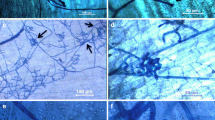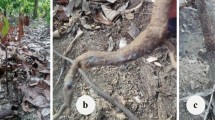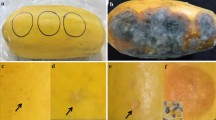Abstract
Fibrous-root decay and epidermal and cortical sloughing were common on blight trees in two citrus groves with severe symptoms in October 1975. These symptoms were present to varying extent on blight trees in other groves, and some fibrous-root decline also was present on apparently healthy trees. Fusarium solani was present in declining fibrous roots of diseased and healthy trees and occurrence appeared to be limited to the fibrous roots. Fusarium infection resulted in early cortical degeneration, leaving epidermal sleeves on intact, infected steles. Generally, in the xylem and cortex with advanced symptoms, only chlamydospores were present. Sites of early infection conained abundant hyphae and immature chlamydospores. Hyphae penetrated the cortex intracellularly and intercellularly, and all cell types of the xylem appeared to be infected predominantly through pits. Fusarium was found on the surface of the epidermis and in broken epidermal cells of healthy-appearing and diseased roots.
Similar content being viewed by others
References
Abawi, G. S. & J. W. Lorbeer. 1971. Pathological histology of four onion cultivars infected by Fusarium oxysporum f. sp. cepae. Phytopathology 61: 1164–1169.
Allen, R. M. & B. R. Gardner. 1965. Dry root rot of citrus induced by ammonia excesses. 8th Annu. Rept. on Soil Fertility and Fertilizer Research. Univ. Arizona, pp. 52–55.
Baker, K. F. & R. J. Cook. 1974. Biological control of plant pathogens. W. H. Freeman and Co., San Francisco. 433 pp.
Beckman, C. H. 1964. Host responses to vascular infection. Annu. Rev. Phytopathol. 2: 231–252.
Bhatnagar, G. C. & N. Prasad. 1966. Studies on Fusarium twig disease of lime (Citrus aurantifolia Swingle). Indian Phytopathol. 19: 257–261.
Childs, J. F. L. 1954. Observations on citrus blight. Proc. Fla. State Hort. Soc. 66: 33–37.
Cohen, M. 1974. Diagnosis of young tree decline, blight and sandhill decline of citrus by measurements of water uptake using gravity injection. Plant Dis. Reptr. 58: 801–805.
Diamond, A. E. 1972. The origin of symptoms of vascular wilt diseases. Pages 289–309. In: Wood, R. K. S., A. Ballio & A. Graniti (eds.). Phytotoxins in plant disease. Academic Press, New York. 530 pp.
Fawcett, H. S. 1923. Gummosis of citrus. J. Agric. Res. 24: 191–236.
Feder, W. A., J. Feldmesser & C. H. Walkinshaw, Jr. 1956. Microorganisms isolated from feeder roots of citrus seedlings affected by spreading decline. Proc. Soil. Crop Sci. Soc. Fla. 16: 127–129.
Feder, W. A. & J. Feldmesser. 1961. The spreading decline complex; the separate and combined effects of Fusarium spp. and Radopholus similis on the growth of Duncan grapefruit seedlings in the greenhouse. Phytopathology 51: 724–726.
Kehr, A. E., M. J. O'Brien & E. W. Davis. 1962. Pathogenicity of Fusarium oxysporum f. sp. cepae and its interaction with Pyrenochaeta terrestris on onion. Euphytica 11: 197–208.
Klotz, L. J. & V. P. Sokoloff. 1943. The possible relation of injury and death of small roots to decline and collapse of citrus and avocado. Calif. Citrograph 28: 86–87.
Kormanik, P. P. & C. L. Brown. 1967. Root buds and the development of root suckers in sweetgum. Forest Sci. 13: 338–345.
Marte, M. & A. Zazzerini. 1973. Vacuolar precipitates in leaves of tomato plants affected by Fusarium. Phytopathol. Z. 77: 252–257.
Martin, J. P. 1948. Fungus flora of some California soils in relation to slow decline of citrus trees. Proc. Amer. Soil Sci. Soc. 12: 209–214.
Martin, J. P. 1950. Effect of soil fungi on germination of sweet orange seeds and development of the young seedlings. Proc. Amer. Soil Sci. Soc. 14: 184–188.
Martin, J. P., L. J. Klotz, T. A. DeWolfe & J. O. Ervin. 1956. Influence of some common soil fungi on growth of citrus seedlings. Soil Sci. 81: 259–267.
McBeth, C. W., A. L. Taylor & A. L. Smith. 1941. Note on staining nematodes in root tissue. Proc. Helminthol. Soc. Wash. 8: 26.
Nash, Shirley M., T. Christou & W. C. Snyder. 1961. Existence of Fusarium solani f. phaseoli as chlamydospores in soil. Phytopathology 51: 308–312.
Nemec, S. 1975. Vessel blockage by myelin forms in citrus with and without rough lemon decline symptoms. Can. J. Bot. 53: 102–108.
Nemec, S. 1975. Microorganisms associated with healthy and sandhill-declined citrus roots. Plant Dis. Reptr. 59: 210–213.
Nemec, S., R. Constant & M. Patterson. 1975. Distribution of obstructions to water movement in citrus with and without blight. Proc. Fla. State Hort. Soc. 88: 70–75.
Neraec, S., D. Fox & G. Horvath. 1976. The relation of subsurface hardpan to blight of citrus and development of root systems. Proc. Fla. Soil and Crop Sci. Soc. 36: 141–144.
Nemec, S., J. H. O'Bannon & H. Burnett. 1976. Symptomatology and histppathology of blight-diseased citrus roots infected with Fusarium solani. Proc. Amer. Phytopath. Soc. 3: 222.
O'Bannon, J. H. 1965. The relationship of the interaction between the citrus nematode (Tylenchulus semipenetrans) and Fusarium spp. to infection of rough lemon (Citrus limon). Ph.D. Diss. Arizona State Univ. 103 pp.
O'Bannon, J. H., C. R. Leathers & H. W. Reynolds. 1967. Interactions of Tylenchulus semipenetrans and Fusarium species on rough lemon (C. limon). Phytopathology 57: 414–417.
Rawlins, T. B. 1933. Phytopathological and botanical research methods. John Wiley and Sons, New York. 156 pp.
Rhoads, A. S. 1936. Blight-a nonparasitic disease of citrus trees. Fla. Agric. Exp. Sta. Bull. 296. 64 pp.
Sherbakoff, C. D. 1953. Fusaria associated with citrus feeder roots in Florida. Phytopathology 43: 395–397.
Takatsu, A. & J. C. Dianese. 1974. Xylem infection of Rangpur lime by Fusarium oxysporum in Brazil. Ciência e Cultura 26(12): 1.153–1.154.
Talboys, P. W. 1968. Water deficits in vascular disease. In: T. T. Kozlowski (ed.), Water deficits and plant growth. Vol. II. Plant water consumption and response. Academic Press, New York.
Thomas, E. E. 1923. The citrus nematode, Tylenchulus semipenetrans. Calif. Agric. Exp. Sta. Tech. Paper 2. 35 pp.
Trujillo, E. E. & W. C. Snyder. 1963. Uneven distribution of Fusarium oxysporum f. cubense in Honduras soils. Phytopathology 53: 167–170.
Van Gundy, S. D. & P. H. Tsao. 1963. Growth reduction of citrus seedlings by Fusarium solani as influenced by the citrus nematode and other soil factors. Phytopathology 53: 488–489.
Webber, I. E. & H. S. Fawcett. 1935. Comparative histology of healthy and psorosis-affected tissues of Citrus sinensis. 9: 71–109.
Author information
Authors and Affiliations
Additional information
This paper reports the results of research only. Mention of a pesticide in this paper does not constitute a recommendation for use by the U.S. Department of Agriculture, nor does it imply registration under FIFRA as amended. Mention of a trademark or proprietary product does not constitute a guarantee or warranty of the product by the U.S. Department of Agriculture and does not imply its approval to the exclusion of other products that may also be suitable.
Rights and permissions
About this article
Cite this article
Nemec, S. Symptomatology and histopathology of fibrous roots of rough lemon (citrus limon) infected with Fusarium solani. Mycopathologia 63, 35–40 (1978). https://doi.org/10.1007/BF00473157
Issue Date:
DOI: https://doi.org/10.1007/BF00473157




